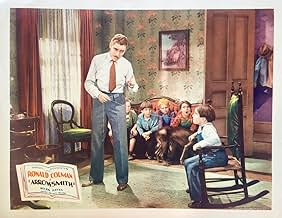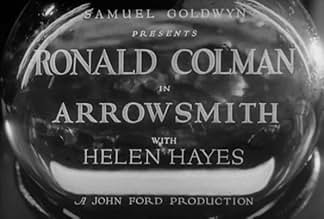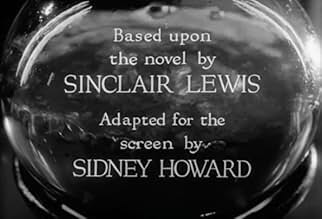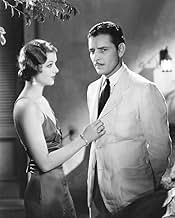NOTE IMDb
6,2/10
2,2 k
MA NOTE
Un jeune médecin lutte contre la peste aux Indes Occidentales, tandis que sa femme cherche désespérément de l'attention.Un jeune médecin lutte contre la peste aux Indes Occidentales, tandis que sa femme cherche désespérément de l'attention.Un jeune médecin lutte contre la peste aux Indes Occidentales, tandis que sa femme cherche désespérément de l'attention.
- Réalisation
- Scénario
- Casting principal
- Nommé pour 4 Oscars
- 4 victoires et 4 nominations au total
Alec B. Francis
- Twyford
- (as Alec Francis)
Erville Alderson
- Pioneer
- (non crédité)
Beulah Bondi
- Mrs. Tozer
- (non crédité)
Florence Britton
- Miss Twyford
- (non crédité)
Josephine Brown
- West Indies Village Bride
- (non crédité)
Nora Cecil
- Nurse
- (non crédité)
Avis à la une
Even though only around a third of John Ford's pictures are westerns, it's still undeniable that his forte or, if you prefer, his comfort zone was in historical pictures of some sort. Arrowsmith is unusual in that it is a contemporary drama that Ford both directed and co-produced.
In spite of the above, you might think this was indeed a western from the opening scene, in which we see an ancestor of the protagonist as a good ol' covered wagon pioneer. This bit of family history is not brought up again, but it was obviously judged by Ford and Sam Goldwyn to be significant enough to open the film with, even though it would have been one of the most expensive scenes of the shoot (unless that opening shot is lifted from somewhere else, which it may well be). The point seems to be to draw a line between the struggles of the pioneers and the main story of a medical scientist torn between his home life and his career. It seems a rather tenuous comparison.
On the other hand, there could be parallels between Dr Arrowsmith and a typical Fordian westerner. Not in the character as written – I'm no auteur theorist – but in the way Ford shoots their environments. In the majority of Ford films he exaggerates the smallness of interiors and the vastness of exteriors. The homestead is safe, yet dull, and the great outdoors is exciting yet dangerous. The village where Arrowsmith practices as a country doctor is shot in much the same way as Ford would a western settlement – cramped interiors, foreground clutter and heavy use of framing. However the medical research centre, while it may be another interior, is shot so as to show off its openness and stark cleanliness, with corridors and waiting rooms so vast they look almost surreal. This is Arrowsmith's "wild west", where he is free to be a pioneer of another sort. Another tenuous comparison? Maybe, but remember directors have many choices of how to shoot a place, regardless of the script or the set design, and these choices will reflect how they view that space and what they feel it means to the story.
While Ford's use of space developed incredibly early on, the camera movement at this stage is not yet of the "invisible camera" technique that later became his standard. For those that don't know, invisible camera means you only move the camera when it's following an action, say for example a character walking to the other end of the room. If everyone in the scene is sitting still, the camera sits still. If it's done properly the audience doesn't notice the camera movement, hence "invisible camera". And yet here there is rather a lot of obtrusive camera movement. This is pretty much in line with the general style of the time, in spite of the myth that cameras were immobilised in the early sound era. Despite a few teething problems that were mostly solved by the end of 1929, cameras of the early talkies zipped around just as giddily of those of the late silents.
Ford is not known to have given his actors much coaching, nor allow them rehearsals or repeated takes to hone their performance. For this reason the acting in his pictures tends to be only as good as the raw talent of the performers. Ronald Coleman and Helen Hayes were both good dramatic actors, and here they give good – but not outstanding – dramatic performances. Richard Bennett however just gives a fairly standard, slightly comical supporting-player performance as Sondelius, and the part should either have been cast differently or he should have been prompted to play it with more conviction.
The story goes that the hard-drinking Ford was contracted by Goldwyn to remain teetotal until the production wrapped. Apparently Ford, eager to get back to the bottle, rushed the shooting even more than usual, tearing pages out of the script wherever he could get away with it. Whether this is true or just another bit of Ford mythology, it certainly makes sense. In particular the love story, crucial to the picture's impact, is massively underdeveloped. Downplaying the romantic angle is actually very typical of Ford, but even the usual Fordian semi-improvised comedy diversions are absent – with the exception of a couple of nice gags in a scene where a boy has his tooth pulled, and an almost surreal moment where a comedy drunk inexplicably wanders on and off the set. The resultant picture is full of great moments, but overall seems a little undernourished. Arrowsmith could have been an intense and poignant drama, but Ford was the wrong man for the job.
In spite of the above, you might think this was indeed a western from the opening scene, in which we see an ancestor of the protagonist as a good ol' covered wagon pioneer. This bit of family history is not brought up again, but it was obviously judged by Ford and Sam Goldwyn to be significant enough to open the film with, even though it would have been one of the most expensive scenes of the shoot (unless that opening shot is lifted from somewhere else, which it may well be). The point seems to be to draw a line between the struggles of the pioneers and the main story of a medical scientist torn between his home life and his career. It seems a rather tenuous comparison.
On the other hand, there could be parallels between Dr Arrowsmith and a typical Fordian westerner. Not in the character as written – I'm no auteur theorist – but in the way Ford shoots their environments. In the majority of Ford films he exaggerates the smallness of interiors and the vastness of exteriors. The homestead is safe, yet dull, and the great outdoors is exciting yet dangerous. The village where Arrowsmith practices as a country doctor is shot in much the same way as Ford would a western settlement – cramped interiors, foreground clutter and heavy use of framing. However the medical research centre, while it may be another interior, is shot so as to show off its openness and stark cleanliness, with corridors and waiting rooms so vast they look almost surreal. This is Arrowsmith's "wild west", where he is free to be a pioneer of another sort. Another tenuous comparison? Maybe, but remember directors have many choices of how to shoot a place, regardless of the script or the set design, and these choices will reflect how they view that space and what they feel it means to the story.
While Ford's use of space developed incredibly early on, the camera movement at this stage is not yet of the "invisible camera" technique that later became his standard. For those that don't know, invisible camera means you only move the camera when it's following an action, say for example a character walking to the other end of the room. If everyone in the scene is sitting still, the camera sits still. If it's done properly the audience doesn't notice the camera movement, hence "invisible camera". And yet here there is rather a lot of obtrusive camera movement. This is pretty much in line with the general style of the time, in spite of the myth that cameras were immobilised in the early sound era. Despite a few teething problems that were mostly solved by the end of 1929, cameras of the early talkies zipped around just as giddily of those of the late silents.
Ford is not known to have given his actors much coaching, nor allow them rehearsals or repeated takes to hone their performance. For this reason the acting in his pictures tends to be only as good as the raw talent of the performers. Ronald Coleman and Helen Hayes were both good dramatic actors, and here they give good – but not outstanding – dramatic performances. Richard Bennett however just gives a fairly standard, slightly comical supporting-player performance as Sondelius, and the part should either have been cast differently or he should have been prompted to play it with more conviction.
The story goes that the hard-drinking Ford was contracted by Goldwyn to remain teetotal until the production wrapped. Apparently Ford, eager to get back to the bottle, rushed the shooting even more than usual, tearing pages out of the script wherever he could get away with it. Whether this is true or just another bit of Ford mythology, it certainly makes sense. In particular the love story, crucial to the picture's impact, is massively underdeveloped. Downplaying the romantic angle is actually very typical of Ford, but even the usual Fordian semi-improvised comedy diversions are absent – with the exception of a couple of nice gags in a scene where a boy has his tooth pulled, and an almost surreal moment where a comedy drunk inexplicably wanders on and off the set. The resultant picture is full of great moments, but overall seems a little undernourished. Arrowsmith could have been an intense and poignant drama, but Ford was the wrong man for the job.
The fact that an idealistic medical doctor was the protagonist in Arrowsmith is the reason why John Ford must have been attracted to this story and agreed to film it for Sam Goldwyn.
Allegedly it was not a happy collaboration. Two very individualistic men wanted to have their imprimatur on the film. They never worked together on a finished product again, though Ford did start filming The Adventures of Marco Polo for Goldwyn and quit.
I read the novel way back in the day when I was in high school and we only get the second half of it. There's a great deal in the book before Ronald Colman as Martin Arrowsmith goes to work for the Research Foundation and A.E. Anson as Max Gottlieb. You miss quite a lot of the character development of Arrowsmith.
Of course the plot mostly centers on Colman and his other mentor, Richard Bennett going to a Caribbean Island where there has been an outbreak of plague. Along for the trip is Helen Hayes who is Colman's wife Leora.
Colman is there to test a new serum and he's under orders as a researcher to only administer the real stuff to half his patient and a placebo to the others as a control group. This is where the racism of the time kicks in as these human guinea pigs are black, probably the descendants of runaway slaves. There is a black doctor named Marchand in the cast played by Oliver Brooks and it is a rarity among black performers at the time in that the role was hardly servile at all. Brooks seems to go along with the controlled experiment, but he becomes one of many in the cast to meet a tragic end.
With some of what came out about the Tuskegee experiments later on Arrowsmith may have been quite on target without knowing it. A harrowing thought.
Colman and Hayes are an attractive pair of leads. Myrna Loy has a much abbreviated role in the film as a New York socialite that Colman meets down in the islands. In the book he has an affair with her and marries her later on. You won't see that here.
Arrowsmith is a good film though I wish more of Lewis's story got into the final product. But it probably would have run for three hours and films just didn't do that back then.
Allegedly it was not a happy collaboration. Two very individualistic men wanted to have their imprimatur on the film. They never worked together on a finished product again, though Ford did start filming The Adventures of Marco Polo for Goldwyn and quit.
I read the novel way back in the day when I was in high school and we only get the second half of it. There's a great deal in the book before Ronald Colman as Martin Arrowsmith goes to work for the Research Foundation and A.E. Anson as Max Gottlieb. You miss quite a lot of the character development of Arrowsmith.
Of course the plot mostly centers on Colman and his other mentor, Richard Bennett going to a Caribbean Island where there has been an outbreak of plague. Along for the trip is Helen Hayes who is Colman's wife Leora.
Colman is there to test a new serum and he's under orders as a researcher to only administer the real stuff to half his patient and a placebo to the others as a control group. This is where the racism of the time kicks in as these human guinea pigs are black, probably the descendants of runaway slaves. There is a black doctor named Marchand in the cast played by Oliver Brooks and it is a rarity among black performers at the time in that the role was hardly servile at all. Brooks seems to go along with the controlled experiment, but he becomes one of many in the cast to meet a tragic end.
With some of what came out about the Tuskegee experiments later on Arrowsmith may have been quite on target without knowing it. A harrowing thought.
Colman and Hayes are an attractive pair of leads. Myrna Loy has a much abbreviated role in the film as a New York socialite that Colman meets down in the islands. In the book he has an affair with her and marries her later on. You won't see that here.
Arrowsmith is a good film though I wish more of Lewis's story got into the final product. But it probably would have run for three hours and films just didn't do that back then.
Based off the Lewis Sinclair epic, Arrowsmith follows a young doctor's journey as he explores different avenues of medicine and research. As you might expect, from page-to-screen, a little ends up on the cutting room floor. Still, if you like medical movies, you'll probably want to give this classic a try. It reminded me of a cross between The Citadel and The Doctor and the Girl.
As I've frequently said, there are two sides to Ronald Colman, and Arrowsmith contains the version with a stick perpetually lodged somewhere uncomfortable. He's not as passionate as he is in other movies, so keep that in mind. For a better first impression of him, try A Tale of Two Cities. You'll get a fine first impression of Helen Hayes, though, who plays his long-suffering wife. She's young and pretty in this one, a far cry from her Miss Marple little-old-lady persona of later decades. She has more passion than her husband, and she repeatedly pushes him to pursue his medical interest, even at the expense of their personal life. She never wants to be left behind, and she follows him all around the world as he conducts research for the bubonic plague.
You'll see Myrna Loy for about five minutes, but it's not her movie, so don't expect anything other than a pretty face. Colman and Hayes have pretty faces, too, and it is always fun to see a very old movie, but it's not my favorite. I like The Doctor and the Girl better, so if you find this movie lacking, you might want to check out Glenn Ford's take on it.
As I've frequently said, there are two sides to Ronald Colman, and Arrowsmith contains the version with a stick perpetually lodged somewhere uncomfortable. He's not as passionate as he is in other movies, so keep that in mind. For a better first impression of him, try A Tale of Two Cities. You'll get a fine first impression of Helen Hayes, though, who plays his long-suffering wife. She's young and pretty in this one, a far cry from her Miss Marple little-old-lady persona of later decades. She has more passion than her husband, and she repeatedly pushes him to pursue his medical interest, even at the expense of their personal life. She never wants to be left behind, and she follows him all around the world as he conducts research for the bubonic plague.
You'll see Myrna Loy for about five minutes, but it's not her movie, so don't expect anything other than a pretty face. Colman and Hayes have pretty faces, too, and it is always fun to see a very old movie, but it's not my favorite. I like The Doctor and the Girl better, so if you find this movie lacking, you might want to check out Glenn Ford's take on it.
Goldwyn put together a lot of fine talent here, but none of it jells.
Ronald Colman, Laurence Olivier's idol and one of the screen's most likable actors, is just plain miscast. Helen Hayes projects annoyingly to the audience, stage fashion, rather than letting the camera discover her emotions, as even the young Myrna Loy knows how to do. Richard Bennett is enjoyably over-the-top as Sondelius but A. E. Anson's accent is a deal-breaker as Gottlieb (as if there weren't enough real Middle European actors in Hollywood at the time).
Sydney Howard's script is condensed to the point of silliness - the other reviewers here who contrast "Gone With the Wind" as a model of condensation are praising an uncredited Ben Hecht, not Sydney Howard. Ray June's fluid cinematography is beautiful throughout, with more than one shot that would wind up re-used in Ford's "The Searchers" many years later.
The story is that Goldwyn hired a bibulous Ford on condition that the director couldn't take one drink during production. Helen Hayes noticed that as the shoot progressed, Ford started discarding pages and then whole scenes, in a race to finish the film and get back to his booze. That may be one more reason that the film is barely coherent.
Hey, nobody's perfect all the time.
Ronald Colman, Laurence Olivier's idol and one of the screen's most likable actors, is just plain miscast. Helen Hayes projects annoyingly to the audience, stage fashion, rather than letting the camera discover her emotions, as even the young Myrna Loy knows how to do. Richard Bennett is enjoyably over-the-top as Sondelius but A. E. Anson's accent is a deal-breaker as Gottlieb (as if there weren't enough real Middle European actors in Hollywood at the time).
Sydney Howard's script is condensed to the point of silliness - the other reviewers here who contrast "Gone With the Wind" as a model of condensation are praising an uncredited Ben Hecht, not Sydney Howard. Ray June's fluid cinematography is beautiful throughout, with more than one shot that would wind up re-used in Ford's "The Searchers" many years later.
The story is that Goldwyn hired a bibulous Ford on condition that the director couldn't take one drink during production. Helen Hayes noticed that as the shoot progressed, Ford started discarding pages and then whole scenes, in a race to finish the film and get back to his booze. That may be one more reason that the film is barely coherent.
Hey, nobody's perfect all the time.
Arrowsmith (1931)
*** (out of 4)
John Ford's adaptation of Sinclair Lewis' novel about a young doctor (Ronald Coleman) who constantly fears that he's not as good as everyone says. The doctor keeps struggling with his duties to his profession as well as his duties to his wife (Helen Hayes). I wasn't expecting too much out of this film but was pleasantly surprised how much I enjoyed it even with all of its flaws. Ford's direction is fairly weak as he never really brings any flair to the material but this is made up with some terrific performances. Coleman steals the film and really delivers all the goods as he's able to show the frustrations of a doctor trying to do the right thing for everyone. Hayes is also very good in her supporting role as is the supporting cast, which includes Richard Bennett, A.E. Anson and Myrna Loy.
*** (out of 4)
John Ford's adaptation of Sinclair Lewis' novel about a young doctor (Ronald Coleman) who constantly fears that he's not as good as everyone says. The doctor keeps struggling with his duties to his profession as well as his duties to his wife (Helen Hayes). I wasn't expecting too much out of this film but was pleasantly surprised how much I enjoyed it even with all of its flaws. Ford's direction is fairly weak as he never really brings any flair to the material but this is made up with some terrific performances. Coleman steals the film and really delivers all the goods as he's able to show the frustrations of a doctor trying to do the right thing for everyone. Hayes is also very good in her supporting role as is the supporting cast, which includes Richard Bennett, A.E. Anson and Myrna Loy.
Le saviez-vous
- AnecdotesCensorship at the time meant that the subplot of Arrowsmith's liaison with another woman while still married meant that most of Myrna Loy's scenes were drastically cut. Although every attempt was made to restore the present version to its original length, there are still about 10 minutes missing.
- GaffesArrowsmith conducts a trial of his serum by giving it to half the potential plague victims and giving the other half nothing. Anyone who tried this in real life would provoke protests, if not riots. So these trials are conducted by giving half the people a placebo and not telling anyone which they are getting.
- Citations
Dr. Martin Arrowsmith: God give me clear eyes and freedom from haste. God give me anger against all pretense. God keep me looking for my own mistakes. God keep me at it till my results are proven. God give me strength not to trust to God.
- Crédits fousOpening credits prologue: The story of a man who dedicated his life to service and his heart to the love of one woman.
- Versions alternativesMyrna Loy's role was substantially reduced when the film was reissued because the Production Code had taken effect. The missing scenes have been restored on the DVD.
- ConnexionsReferenced in Citizen Kane (1941)
- Bandes originalesWilliam Tell Overture
(1829) (uncredited)
Written by Gioachino Rossini
Played on piano from a recording
Meilleurs choix
Connectez-vous pour évaluer et suivre la liste de favoris afin de recevoir des recommandations personnalisées
- How long is Arrowsmith?Alimenté par Alexa
Détails
- Durée
- 1h 48min(108 min)
- Couleur
- Rapport de forme
- 1.20 : 1
Contribuer à cette page
Suggérer une modification ou ajouter du contenu manquant

























